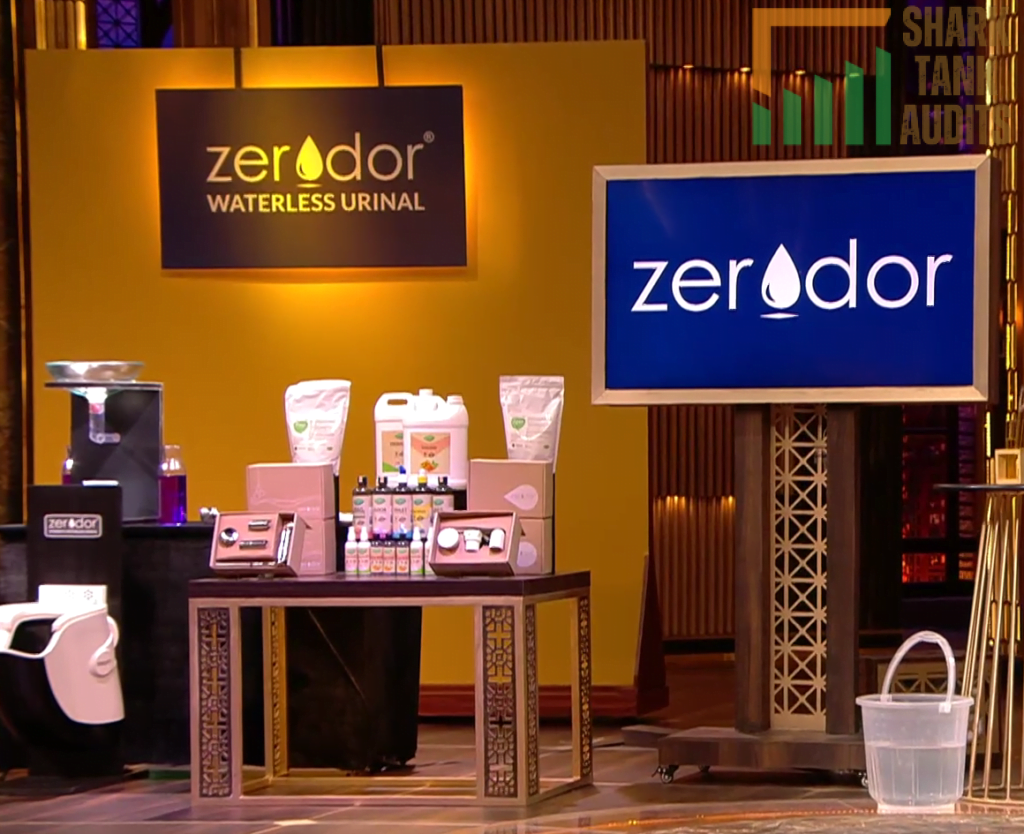Zerdor Waterless Urinal Shark Tank India Episode Review
Website Information:
- Website:- Zerdor Waterless Urinal
- Built on WIX CMS
- No Website Data was found.
Founders:
- The founders are Sachin Joshi and Uttam Banerjee
- Uttam Banerjee, who pursued Product Design at IIT Delhi, boasts a record of winning numerous awards for his designs. With more than 14 years of combined experience in Corporate and Startup environments, Uttam leads the realms of Product Development, Management, and Marketing.
- Sachin Joshi, an adept engineering manager, boasts a track record of successfully overseeing substantial projects during his tenure at Crompton Greaves. With more than two decades of corporate expertise under his belt, he currently oversees Planning & Operations at Ekam.
The Vision
- The business vision for Zerdor Waterless Urinal is to revolutionize the sanitation industry by providing innovative, eco-friendly solutions that conserve water and promote sustainability.
- Through cutting-edge technology and a commitment to environmental stewardship, Zerdor Waterless Urinal aims to establish itself as a global leader in waterless urinal systems, enhancing hygiene standards while reducing water consumption worldwide.

Key Points:
- Zerodor Waterless Urinal is a waterless urinal system that does not require any water or chemicals to flush.
- The Zerdor Waterless Urinal claims that its system can save up to 100,000 liters of water per year per urinal.
- Zerodor is seeking an investment of ₹1 crore for a 10% equity stake in the company.
- The sharks are impressed with the Zerdor Waterless Urinal’s product and its potential to save water, but they are concerned about the company’s valuation and its ability to scale.
- Aman Gupta offers ₹50 lakhs for 20% equity, Peyush Bansal offers ₹75 lakhs for 25% equity, and Namita Thapar offers ₹50 lakhs for 15% equity.
- The founders Sachin Joshi and Uttam Banerjee ultimately decide to go with Peyush Bansal’s offer.
Detailed Summary:
Zerodor Waterless Urinal is a waterless urinal system that does not require any water or chemicals to flush. The system uses a cartridge that contains a special absorbent material that traps urine and odors. The cartridge is then replaced every 30-45 days.
The Zerdor Waterless Urinal claims that its system can save up to 100,000 liters of water per year per urinal. This is a significant amount of water, especially in India, where water scarcity is a major problem.
Zerdor Waterless Urinal is seeking an investment of ₹1 crore for a 10% equity stake in the company. The company plans to use the investment to expand its sales and marketing efforts and to develop new products.
The sharks are impressed with the company’s product and its potential to save water. However, they are concerned about the company’s valuation and its ability to scale.
Aman Gupta offers ₹50 lakhs for 20% equity, Peyush Bansal offers ₹75 lakhs for 25% equity, and Namita Thapar offers ₹50 lakhs for 15% equity.
The founders ultimately decide to go with Peyush Bansal’s offer. They believe that Peyush Bansal’s experience and expertise in the e-commerce industry will be valuable in helping Zerodor grow its business.
Conclusion:
Zerodor Waterless Urinal is a promising company with a product that has the potential to make a significant impact on water conservation. The company has a strong team with experience in the water and sanitation industry. The sharks’ investment will help Zerodor expand its reach and make a positive impact on the environment.
| Category | Information | Details |
|---|---|---|
| Founders | Name | Sachin Joshi & Uttam Banerjee |
| Background | Joshi: Engineering manager with 20+ years experience; Banerjee: Product designer with 14+ years experience | |
| Vision | Statement | Revolutionize sanitation with eco-friendly waterless urinals |
| Goals | Become global leader in waterless urinals, enhance hygiene, reduce water consumption | |
| Product | Name | Zerdor Waterless Urinal |
| Description | Waterless urinal system, no flush required | |
| Water Savings | 100,000 liters per year per urinal | |
| Investment Ask | Amount | ₹1 crore |
| Equity Stake | 10% | |
| Shark Opinions | ||
| Become a global leader in waterless urinals, enhance hygiene, reduce water consumption | Yes | |
| Concerned about valuation and scaling | Yes | |
| Shark Offers | Name | Offer |
| Aman Gupta | ₹50 lakhs for 20% equity | |
| Peyush Bansal | ₹75 lakhs for 25% equity | |
| Namita Thapar | ₹50 lakhs for 15% equity | |
| Final Decision | Chosen Shark | Peyush Bansal |
| Reason | Experience in e-commerce will be valuable | |
| Conclusion | Promising company with potential impact | Yes |
| Strong team with relevant experience | Yes | |
| Shark investment will aid growth and impact | Yes | |
| Additional Information | Founders’ Background | Joshi: IIT Delhi graduate; Banerjee: IIT Delhi alumnus |
| Website | Built on WIX CMS, no data found |
Zerdor Waterless Urinal: Business Plan
| Business Potential in India | Sanitation Market Size | $58.6 billion by 2027, CAGR 14.51% |
| Water Scarcity | 21 cities projected to run out of groundwater by 2020 | |
| Government Initiatives | Swachh Bharat Abhiyan campaign emphasizes sanitation improvement | |
| Total Addressable Market (TAM) | Target Audience | Urban population with access to public restrooms |
| Estimated TAM | 150 million individuals in Tier 1 & 2 cities | |
| Ideal Target Audience | Demographics | Aged 25-55, professionals, environmentally conscious, tech-savvy |
| Psychographics | Value hygiene, convenience, and sustainability | |
| Marketing Strategy | Digital Marketing | SEO, social media, influencer marketing, content marketing |
| Partnerships | Building management companies, sanitation providers, NGOs | |
| Direct Sales | Target corporate offices and institutions | |
| Promotional Offers | Trial programs, bulk purchase discounts | |
| Content & Digital Marketing Strategy | Content | Water conservation, hygiene benefits, product features |
| Social Media | Engaging posts, user-generated content, influencer collaborations | |
| Targeted Advertising | Reach specific demographics and interests online | |
| SEO Optimization | Ensure easy website discoverability | |
| Distribution Strategy | Direct Sales | Online store, sales team targeting businesses |
| Distributors | Partner with regional distributors for wider reach | |
| E-commerce Platforms | List products on Amazon, Flipkart, etc. | |
| Advantages | Water Conservation | Saves up to 100,000 liters per year per urinal |
| Reduced Costs | Lower water and sewage bills for businesses | |
| Hygiene | Odor-free and hygienic operation | |
| Sustainability | Eco-friendly solution aligned with government initiatives | |
| Challenges | Competition | Established players in sanitation industry |
| Consumer Awareness | Educating customers about waterless urinals | |
| Initial Cost | Higher upfront cost compared to traditional urinals | |
| Maintenance | Need for regular cartridge replacements | |
| Reasons for Success | Unique Value Proposition | Addresses water scarcity and promotes sustainability |
| Cost-Effective | Saves money on water and sewage bills in the long run | |
| Strong Branding & Marketing | Create awareness and build trust with target audience | |
| Strategic Partnerships | Leverage existing networks and expertise | |
| Mitigation Strategies | Competitive Differentiation | Highlight unique features and benefits |
| Customer Education | Provide clear information about water savings and cost benefits | |
| Flexible Pricing | Offer rental or subscription models to reduce upfront costs | |
| Efficient Supply Chain | Optimize logistics and reduce maintenance costs | |
| Future Roadmap | Expand Product Line | Offer waterless toilets and other sanitation solutions |
| Enter New Markets | Target rural areas and international markets | |
| Technology Development | Research and develop advanced waterless technologies | |
| Strategic Acquisitions | Acquire complementary businesses for growth | |
| Increasing Valuation | Sustainable Revenue Growth | Focus on customer acquisition, retention, and increasing average order value |
| Profitability | Streamline operations, optimize costs, and explore new revenue streams | |
| Brand Building | Invest in marketing, PR, and building brand awareness |

1. Business Potential in India:
- Sanitation Market Size: India’s sanitation market is expected to reach $58.6 billion by 2027, growing at a CAGR of 14.51% (Source: Mordor Intelligence).
- Water Scarcity: India faces severe water scarcity, with 21 cities projected to run out of groundwater by 2020 (Source: NITI Aayog).
- Government Initiatives: The Swachh Bharat Abhiyan campaign emphasizes sanitation improvement, creating demand for innovative solutions.
2. Total Addressable Market (TAM):
- Target Audience: Urban population with access to commercial and public restrooms (malls, offices, educational institutions, etc.).
- Estimated TAM: Approximately 150 million individuals in Tier 1 and Tier 2 cities (Source: Census 2021).
3. Ideal Target Audience:
- Demographics: Individuals aged 25-55, professionals, environmentally conscious, tech-savvy.
- Psychographics: Value hygiene, convenience, and sustainability.
4. Marketing Strategy:
- Digital Marketing: SEO, social media (Instagram, Facebook), influencer marketing, content marketing (blogs, articles, tutorials).
- Partnerships: Collaborate with building management companies, sanitation service providers, NGOs.
- Direct Sales: Target corporate offices and institutions directly.
- Promotional Offers: Trial programs, discounts for bulk purchases.
5. Content and Digital Marketing Strategy:
- Content: Educational content on water conservation, hygiene benefits, and product features.
- Social Media: Engaging posts, user-generated content, and collaborations with influencers.
- Targeted Advertising: Reach specific demographics and interests online.
- SEO Optimization: Ensure easy website discoverability through search engines.
6. Distribution Strategy:
- Direct Sales: Online store, sales team targeting specific businesses.
- Distributors: Partner with regional distributors for wider reach.
- E-commerce Platforms: List products on Amazon, Flipkart, and other online marketplaces.
7. Advantages:
- Water Conservation: Saves up to 100,000 liters of water per year per urinal.
- Reduced Costs: Lower water and sewage bills for businesses.
- Hygiene: Odor-free and hygienic operation.
- Sustainability: Eco-friendly solution aligned with government initiatives.
8. Challenges:
- Competition: Established players in the sanitation industry.
- Consumer awareness: Educating customers about the benefits of waterless urinals.
- Initial cost: Higher upfront cost compared to traditional urinals.
- Maintenance: Need for regular cartridge replacements.
9. Reasons for Success:
- Unique Value Proposition: Addresses water scarcity and promotes sustainability.
- Cost-Effective in the Long Run: Saves money on water and sewage bills.
- Strong Branding and Marketing: Create awareness and build trust with the target audience.
- Strategic Partnerships: Leverage existing networks and expertise.
10. Mitigation Strategies:
- Competitive Differentiation: Highlight unique features and benefits.
- Customer Education: Provide clear information about water savings and cost benefits.
- Flexible Pricing: Offer rental or subscription models to reduce upfront costs.
- Efficient Supply Chain: Optimize logistics and reduce maintenance costs.
11. Future Roadmap:
- Expand Product Line: Offer waterless toilets and other sanitation solutions.
- Enter New Markets: Target rural areas and international markets.
- Technology Development: Research and develop advanced waterless technologies.
- Strategic Acquisitions: Acquire complementary businesses for growth.
12. Increasing Valuation:
- Sustainable Revenue Growth: Focus on customer acquisition, retention, and increasing average order value.
- Profitability: Streamline operations, optimize costs, and explore new revenue streams.
- Brand Building: Invest in marketing, PR, and building brand awareness.



